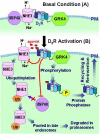Dopamine Receptor D1R and D3R and GRK4 Interaction in Hypertension
- PMID: 37009199
- PMCID: PMC10052590
- DOI: 10.59249/MKRR9549
Dopamine Receptor D1R and D3R and GRK4 Interaction in Hypertension
Abstract
Essential hypertension is caused by the interaction of genetic, behavioral, and environmental factors. Abnormalities in the regulation of renal ion transport cause essential hypertension. The renal dopaminergic system, which inhibits sodium transport in all the nephron segments, is responsible for at least 50% of renal sodium excretion under conditions of moderate sodium excess. Dopaminergic signals are transduced by two families of receptors that belong to the G protein-coupled receptor (GPCR) superfamily. D1-like receptors (D1R and D5R) stimulate, while D2-like receptors (D2R, D3R, and D4R) inhibit adenylyl cyclases. The dopamine receptor subtypes, themselves, or by their interactions, regulate renal sodium transport and blood pressure. We review the role of the D1R and D3R and their interaction in the natriuresis associated with volume expansion. The D1R- and D3R-mediated inhibition of renal sodium transport involves PKA and PKC-dependent and -independent mechanisms. The D3R also increases the degradation of NHE3 via USP-mediated ubiquitinylation. Although deletion of Drd1 and Drd3 in mice causes hypertension, DRD1 polymorphisms are not always associated with human essential hypertension and polymorphisms in DRD3 are not associated with human essential hypertension. The impaired D1R and D3R function in hypertension is related to their hyper-phosphorylation; GRK4γ isoforms, R65L, A142V, and A486V, hyper-phosphorylate and desensitize D1R and D3R. The GRK4 locus is linked to and GRK4 variants are associated with high blood pressure in humans. Thus, GRK4, by itself, and by regulating genes related to the control of blood pressure may explain the "apparent" polygenic nature of essential hypertension.
Keywords: D1R; D3R; G protein-coupled receptor kinase 4; dopamine receptor; hypertension.
Copyright ©2023, Yale Journal of Biology and Medicine.
Figures

Similar articles
-
Dopamine and G protein-coupled receptor kinase 4 in the kidney: role in blood pressure regulation.Biochim Biophys Acta. 2010 Dec;1802(12):1259-67. doi: 10.1016/j.bbadis.2010.02.004. Epub 2010 Feb 12. Biochim Biophys Acta. 2010. PMID: 20153824 Free PMC article. Review.
-
Downregulation of Renal G Protein-Coupled Receptor Kinase Type 4 Expression via Ultrasound-Targeted Microbubble Destruction Lowers Blood Pressure in Spontaneously Hypertensive Rats.J Am Heart Assoc. 2016 Oct 6;5(10):e004028. doi: 10.1161/JAHA.116.004028. J Am Heart Assoc. 2016. PMID: 27792639 Free PMC article.
-
Reduction of renal dopamine receptor expression in obese Zucker rats: role of sex and angiotensin II.Am J Physiol Renal Physiol. 2010 Nov;299(5):F1164-70. doi: 10.1152/ajprenal.00604.2009. Epub 2010 Sep 1. Am J Physiol Renal Physiol. 2010. PMID: 20810614 Free PMC article.
-
Single-nucleotide polymorphisms for diagnosis of salt-sensitive hypertension.Clin Chem. 2006 Mar;52(3):352-60. doi: 10.1373/clinchem.2005.059139. Epub 2006 Jan 26. Clin Chem. 2006. PMID: 16439609
-
Dopamine and renal function and blood pressure regulation.Compr Physiol. 2011 Jul;1(3):1075-117. doi: 10.1002/cphy.c100032. Compr Physiol. 2011. PMID: 23733636 Free PMC article. Review.
Cited by
-
Role of G-protein-coupled receptor kinase 4 on the dysfunction of renal Mas receptor in hypertension.PLoS One. 2025 Aug 5;20(8):e0329547. doi: 10.1371/journal.pone.0329547. eCollection 2025. PLoS One. 2025. PMID: 40763158 Free PMC article.
-
Renal autocrine neuropeptide FF (NPFF) signaling regulates blood pressure.Sci Rep. 2024 Jul 4;14(1):15407. doi: 10.1038/s41598-024-64484-9. Sci Rep. 2024. PMID: 38965251 Free PMC article.
-
SNX19 Interacts with Caveolin-1 and Flotillin-1 to Regulate D1R Endocytosis and Signaling.Biomedicines. 2025 Feb 15;13(2):481. doi: 10.3390/biomedicines13020481. Biomedicines. 2025. PMID: 40002894 Free PMC article.
-
An Overview on Renal and Central Regulation of Blood Pressure by Neuropeptide FF and Its Receptors.Int J Mol Sci. 2024 Dec 11;25(24):13284. doi: 10.3390/ijms252413284. Int J Mol Sci. 2024. PMID: 39769048 Free PMC article. Review.
References
Publication types
MeSH terms
Substances
Grants and funding
LinkOut - more resources
Full Text Sources
Medical
